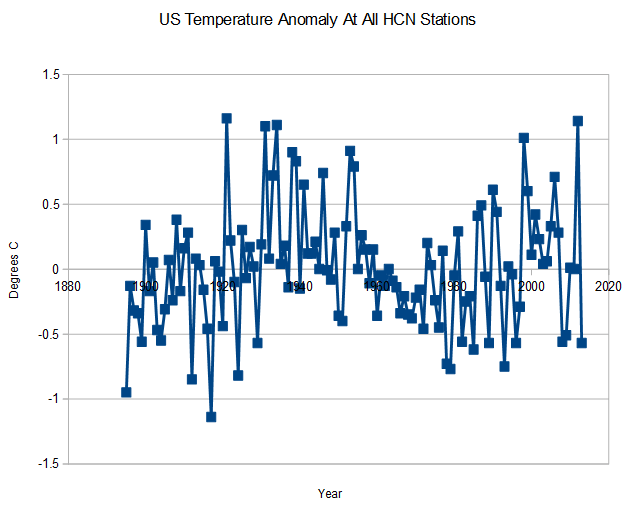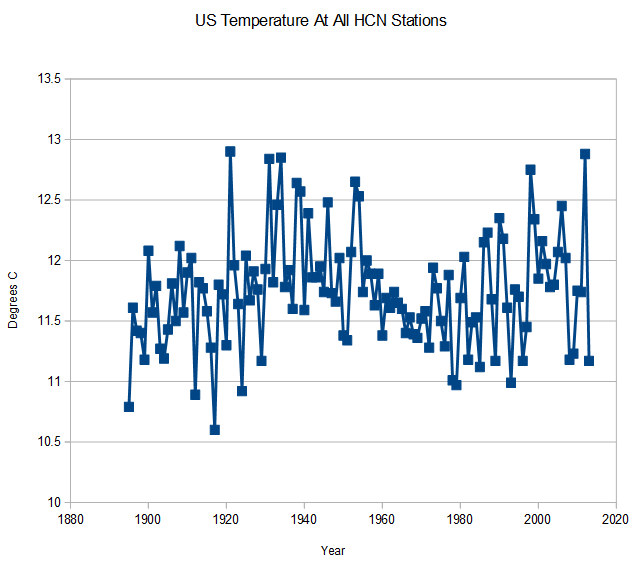A few mathematically illiterate people believe that somehow the use of anomalies would make NCDC data tampering go away. Below are the anomaly and absolute temperature graphs. As you can see, it makes absolutely no difference. All that the use of anomalies does is shift the Y-axis.
The only reason to use anomalies is if you are comparing different time periods during the year.
Obviously it would make no sense to compare absolute temperatures of January-May 2014 with January-December 1934. But comparing January-May 2014 to January-May 1934 is just fine.
Again, I am happy to debate and humiliate anyone who disagrees with this basic mathematics.




No meaningful temperature trend since the Herbert Hoover Administration. But how many billions squandered over so-called global warming?? In a just society, some heads would roll.
I wouldn’t exactly say squandered; the ‘super computer’ makers have appreciated this windfall, but overall this has been a HUGE waste of money, time and resources …
“But how many billions squandered over so-called global warming?? In a just society, some heads would roll.”
President Eisenhower once said, “Every gun that is made, every warship launched, every rocket fired signifies, in the final sense, a theft from those who hunger and are not fed, those who are cold and not clothed. This world in arms is not spending money alone. It is spending the sweat of its laborers, the genius of its scientists, the hopes of its children. This is not a way of life at all in any true sense. Under the cloud of threatening war, it is humanity hanging from a cross of iron.”
Eisenhower’s point is valid not just for war, but for any use of money — even good uses. Even money spent on hospitals means that much less for clothing. When we consider the billions that have been wasted on CAGW terrorism we are not simply talking about dollars — we are talking about human lives. How many villagers have lost their homes from biofuel plantations? How many people have starved because food prices have been forced upward by CAGW policies?
Yes, heads ought to roll. But we here in the Western world have become far too passive, far too “civilized” in a sense. We all want to preserve nature and diverse species — but what rational person would let a cobra live in a playground, or a black widow spider in a child’s bedroom? And yet we let thieves and liars suck the life from our culture and then applaud them when they become rich and powerful.
“Even money spent on hospitals means that much less for clothing.”
This is true only if you think there’s just some static pool of wealth that is rightfully disbursed by a central authority, i.e., the state.
I do think people should think more carefully about out-of-control, unaccountable government spending. My proposal has been to give figures in terms of “working lives” instead of dollar amounts, so instead of talking about X million or billion dollars being pissed down a typical government crony rathole, we would speak of X working lives being wasted — the equivalent of how many human lives full of toil and labor were simply confiscated and disposed of by government criminals.
Dave in Ann Arbor says:
This is true only if you think there’s just some static pool of wealth that is rightfully disbursed by a central authority, i.e., the state….
In reply to:
“Even money spent on hospitals means that much less for clothing.”
>>>>>>>>>>>>>
Actually that is correct.
In a given year, if you have X resources and Y laborers (laborers being the restriction) you can only produce Z products. You then have to figure out how to juggle the human and material resources.
This is one of the biggest arguments going. Some want the government to do ALL the planing (Communism) Some want the market to adjust itself via supply and demand. Between the two is a continuum from no government interference to complete government control.
This does not mean that wealth can not expand over time as we learn to do things smarter and faster as the industrial revolution certainly proved.
I am of the school of getting the government the heck out of the way so we can solve our problems. Federal government should stick to what the Constitution specifically says it can do and leave the rest to the state and local government.
The simplest method would be to require citizens to pay ALL their taxes on April 15th. No hidden sales tax, gas tax…., no withholding… nothing rolled into the price of a product as the cost of regulations. You have to hand every dollar over IN CASH to a tax collector.
We would have a revolution the next day.
I mean, it is true as far as it goes. Yes, at any given point in time, there is a finite amount of resources. But the workings of an economy — which is shorthand for the actions of millions of people constantly working purposefully and generating ever-more wealth through their productive labors (ideally) — aren’t really well captured by some static pie chart.
Steve, can you answer how the climate databases calculate an average temperature?
I see from various papers posted by NOAA that they collect 4 or more temperature readings per day. They then show Tmax, Tmin, and two or more other readings.
Do they determine the average temperature for a day by averaging the maximum and minimum, or by averaging all the readings taken for that day? Or, some other method?